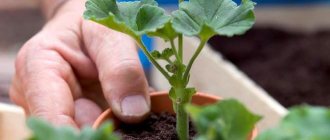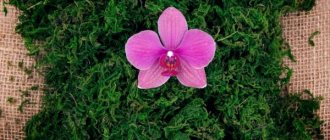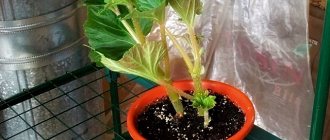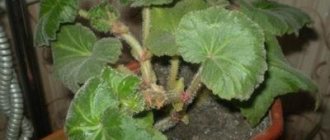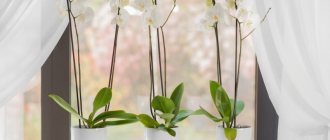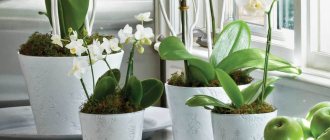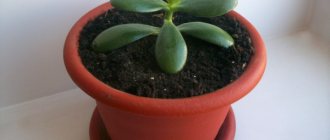Author of the article: Anna Vladimirovna | Updated: 02/20/2022
Set of cleaning products Synergetic Clean Home + GIFT
863 ₽ More details
Set of cleaning products Synergetic Clean Home + GIFT
863 ₽ More details
Floor wax
Begonia is a beautiful plant with a delightful aroma that can decorate not only your home, but even a flowerbed or park. This plant is characterized by a small shrub height - about 25 cm in height. Initially, begonia was grown only in closed greenhouses, and a little later breeders managed to develop species that were resistant to different climates. In our article we will talk about how to plant begonia at home, what its varieties are, how to prepare the soil, and what container to prefer.
How to plant
Almost all flowers of this variety, grown at home, are unpretentious, easy to propagate, and the variety of their colors and shapes of variegated petals decorates and enlivens any room with their presence. Growing begonia at home is extremely interesting.
It grows quickly, in up to 3 months. To be able to admire the flowers at the beginning of summer, it should be planted in March or even February. To plant begonias at home, no special preparation is required. This is done immediately into the prepared pot where it will grow, or into a special peat pot, which should later be placed in its place of permanent residence.
These wonderful plants need to be bred indoors, but in the summer they can be placed in open ground, where they will be at ease and will delight you with abundant flowering throughout the entire summer period. For such a crop, you will need to choose the optimal size pot, as well as worry about the normal composition of the soil and then provide proper care for the plant.
It should be remembered that begonias of various species remain dormant throughout the autumn and winter. Caring for them in summer involves generous watering. But at the same time, proper care does not require flooding the plant too much. In winter, such a flower generally requires watering in moderate quantities when providing comprehensive care. It is recommended to carry it out with warm water. With normal care, the room temperature should be 14 - 22 degrees. Replanting begonias with such care is required as needed. Take care of timely application of fertilizers.
What does the plant suffer from and methods of treatment
Club and decorative deciduous begonia have similar diseases and treatment methods for them.
| Disease | Causes | Treatment |
| The ends of the leaves have dried out | High air temperature | Water thoroughly and move to a place with a lower temperature. |
| Leaves fall in winter | Low air temperature | Find a new, warmer place |
| Newly grown leaves are small | Needs feeding | Feed outside the plan |
| Small bubbles on the leaves | Bacterial wilt | Spray with fungicide |
| White spots on leaves | Powdery mildew | Spray with fungicide |
| The plant is rotting | High humidity | Stop watering the flower frequently |
| Brown plaque in powder form | Gray mold | Spray with fungicide |
| The leaves have become colorless | A worm has appeared - nematodes | There are no treatments. The plant must be thrown away with the pot without touching it with bare hands. |
| Cobwebs appeared on the faded leaves | There is a pest - spider mite | Spray with a chemical such as mallatmon |
| Leaves have yellow spots | Cucumber mosaic virus | There are no treatments. The plant should be thrown away |
This is what powdery mildew looks like. Regular wiping of leaves will result in even larger stains. Therefore, do not torment the plant and waste time in vain - immediately charge the spray bottle with fungicide
Types of planting
Many novice gardeners are interested in how to plant begonia correctly? It is not difficult to do this at home if you have information about planting methods and follow some rules. You can plant such a plant yourself, using its parts such as stems, tubers, leaf cuttings, as well as vegetatively.
Tuberous begonia is propagated at the end of August. To do this, the plant is dug up with a clod of earth. It will need to be dried. A large tuber is formed due to the fact that the leaves gradually dry out in the fall. During wintering, the tuber is placed in a box with sand or peat. Do not forget to periodically moisten the substrate. In spring, the tubers can be planted in the ground.
When planting, the lower part of the tuber should be at the bottom, since the buds are located on the top. It is permissible to divide an adult tuber into several - this way you can actually get many young plants. When vegetatively propagating flowers, children cut off the top of the begonia up to 7 cm long, which is placed in a special powder for rooting. Then the baby is moved into a small pot of soil, which contains peat and coarse sand in equal proportions. The pot is covered with film, and a month later a new fathom starts sprouting.
After this, the plant should be transplanted into a permanent pot. When choosing the type of planting by dividing the tuber, it is cut into a couple of parts so that each has a bud. The cut area is sprinkled with ash; after this, it would be correct to plant the particle in moist soil. Then the pots are covered with film, placed in a bright room, and after rooting the plants are planted in containers for permanent residence. This crop should be fed properly.
When planting begonias with leaf cuttings, the leaves of the plant are cut into squares, which are placed vertically in the substrate. After a couple of weeks, the cuttings, covered with film, will take root, then the cover is removed for ventilation. After which the young plants are planted - each in its own permanent pot. When planting such a magnificent flower with stem cuttings, they are taken with at least 2 nodes. A cut is made, a hole is created in the substrate, into which the future flower is inserted. It is covered with a bag, rooting occurs in 15 - 30 days.
Roots or tubers
To summarize, Begonias can be divided into tuberous and rhizomatous. How do tuberous Begonias from rhizomatous Begonias? And they differ in several parameters.
- Tuberous Begonias have a thickened tuberous rhizome - a tuber with a diameter of up to 6 cm.
- Tuberous Begonias have succulent, herbaceous, translucent stems and heart-shaped leaves with a pointed tip.
- They have a pronounced dormant period from November to February.
- Tuberous Begonias reproduce not only by cuttings and seeds, but also by dividing the tubers, which is much more effective.
Take a couple of minutes and watch the “Video about Begonia” Watch...
Tuberous Begonias are a hybrid species. They are represented by a huge number of varieties, which differ in the size and shape of the flowers, and the configuration of the petals. Tuberous begonias of various selections are united into garden groups: giant (gigantea), large-flowered (grandiflora), profusely flowering (floribunda) and multi-flowered (multiflora).
Soil preparation
Regardless of whether you plan to grow your plants at home in pots or in open ground in the future, you will definitely plant the tuber at home. And only a little later, when your crop gets stronger, grows to a certain level, and there are favorable weather conditions outside, it will be permissible to move it into the soil on your own plot or transplant it into a larger pot.
So that later, for lush and long flowering, you can simply take proper care of your pet. An excellent option for modern gardeners is to purchase a special primer with the optimal composition in the store.
If you know exactly how to properly grow begonia at home and take into account all the nuances, then you can prepare such soil yourself. Its main characteristics should be a loose structure, an increased degree of fertility, and a low level of acidity. The following composition may work well - leaf and turf soil taken in equal parts in combination with compost and perlite. Experts also advise adding rotted humus here in a ratio of 1:10.
Begonia: some information
Michel Begon first described this colorful gift of nature when he saw it in the Antilles. The flower was named after him, and all other open subspecies were assigned to the Begoniev family.
Nowadays, tuberous begonia is the most popular because of its brightness, external beauty and ease of cultivation.
The picture shows an impeccably grown decorative deciduous begonia. Without colorful flowers, it is no less picturesque. Rich, healthy foliage means proper plant care
Which pot to choose
If you decide to propagate this magnificent plant yourself at home and provide it with normal care in the future, a completely understandable question arises - how to choose a pot for such flowers? Cuttings that have already begun to take root are planted in 5–6 cm containers, which must have several drainage holes.
After waiting about 6 months, when the root system has already entangled the earthen ball, the begonia should be transplanted into a larger container. During this period, experts advise purchasing a pot measuring 8 - 10 cm. If the first planting was carried out in the spring, then after a year the crop should be placed in an even larger container. It is determined by the grower independently, based on the size of the formed root system.
This vessel must be one third larger than the one in which your pet currently lives. You cannot plant begonia in a container that is too spacious the first time - this can result in rotting of the delicate root system of the plant. It is recommended to plant the flower gradually, using the transfer method, each time I monitor the condition of the roots and remove a third of the old soil from the container.
Deciduous types of flowers are usually called decorative deciduous. When individual specimens have grown too much, they need to be transplanted into new beautiful containers. In this case, you yourself must choose a beautiful pot for your pet. You just need to remember the rules of planting, drainage and all the nuances of subsequent care for this amazing indoor plant.
Care and feeding
Before the first expanded leaves appear, the plant is not watered and placed in a dark room with a relative humidity of at least 30-40%. After the tuber adapts to the soil, they begin to water it without touching the young shoots.
It is necessary to feed the plant at all stages: growth, transplantation, budding. Experts recommend buying specialized fertilizers for begonias.
- Aquamarine. A liquid concentrate that stimulates shoot growth, promoting intensive leaf formation and flowering.
- BIOPON and Garden of Miracles. Used mainly at the active flowering stage.
- Hylea. Dry powder to prevent root rotting, increasing plant immunity to various pathogens.
- Hello Turbo. Dry fertilizer for feeding the root system.
IMPORTANT: Only one plant is planted in one pot.
In addition to our article, we recommend watching video instructions on how to properly plant tuber begonias in a pot.
Caring for plants after transplantation
After the planting process is completed, the begonia is not watered until the pale shoots begin to grow. All this time, the pot should be in a warm, well-lit room. The lighting should be bright but diffuse. Water when the young shoots begin to turn green. But they water it so that water does not get on either the sprouts or the tuber. Therefore, it is best to immerse the pot in a container of water below the level of the tuber for a short time so that the soil does not become too damp.
After the young shoots rise to a height of 5-6 cm and the first leaves unfold on them, the tuber needs to be sprinkled with earth. After this, adventitious roots will appear on the tuber, which will help the adult plant stay in the soil and not fall out of the pot. Next, begonia should also be watered by immersion.
Diseases and pests
Tuberous varieties of begonias do not get sick often. Sometimes they are attacked by aphids. Sometimes fungal diseases occur:
- powdery mildew,
- gray mold,
- spotting,
- rotting.
You can reduce the risk of disease by growing plants correctly and following the watering regime.
Photo. Powdery mildew on begonia leaves
